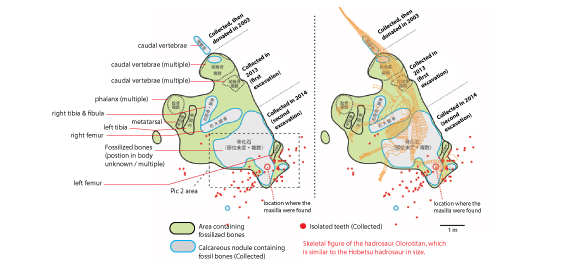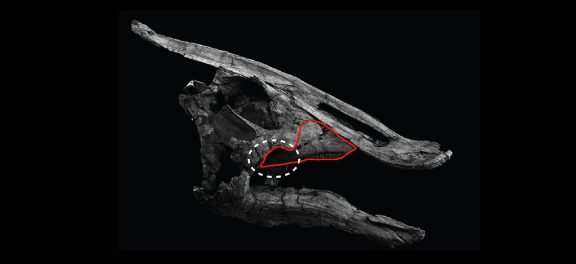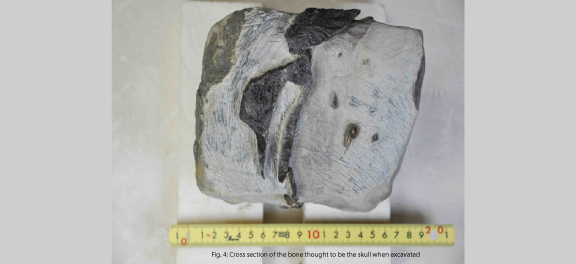Partial Dinosaur Skull Discovered in Hobetsu, Mukawa Town in Hokkaido
Research Press Release | November 12, 2014
-
 Fig. 2 Photo of the dig site and location where the maxilla was discovered (red circle)
Fig. 2 Photo of the dig site and location where the maxilla was discovered (red circle) -
 Fig. 3 Fossil distribution of the hadrosaurid dinosaur discovered at the site, and location where the maxilla and teeth were discovered: Olorotitan without skeleton (left) and with skeleton (right)
Fig. 3 Fossil distribution of the hadrosaurid dinosaur discovered at the site, and location where the maxilla and teeth were discovered: Olorotitan without skeleton (left) and with skeleton (right) -
 Fig. 5 The location of the maxilla (red line) and the area which was confirmed at this time (white dashed line). The skull is of a Saurolophus from Mongolia.
Fig. 5 The location of the maxilla (red line) and the area which was confirmed at this time (white dashed line). The skull is of a Saurolophus from Mongolia.
| Press Release | ||
|---|---|---|
| Key Points | ・The partial maxilla (upper jaw) of a hadrosaur dinosaur was found in rock collected during an excavation in September; the remainder of the skull is thought to still be in the nodule.
・This is the second time dinosaur skulls have been discovered in Hokkaido (The first was the discovery of a partial skull of an ankylosaur in Yubari City); and the third time for a partial skull of a hadrosaur to be discovered in Japan (the other two cases were in Mifune Town, Kumamoto Prefecture, and Sumoto City, Hyogo Prefecture). Based on the time period, this is the second case in Japan dating from the Late Cretaceous Period, following the Hyogo Prefecture find; but the first case for an maxilla bone of a hadrosaur to be discovered in Japan. ・Maxilla contain many important characteristics, and are important for classification and ecological study. |
|
| Overview |
Prior discoveries of fossilized hadrosaurid bones were found in the marine deposits of the Upper Cretaceous Hakobuchi Formation (continental shelf sediments from approximately 72 million years ago, in the 80-200 m water depth range) distributed over Hobetsu, Mukawa Town, Hokkaido (Fig. 1). (See the HU Japanese press releases below.) “Dinosaur fossil found from Hobetsu, Mukawa Town– is it a Hadrosaurid?” (July 17, 2013) URL: http://www.hokudai.ac.jp/news/130717_pr_museum.pdf “2013 Dinosaur Discovery Findings Report– Complete fossilized bone confirmed in Hobetsu, Mukawa Town” (January 17, 2014) URL: http://www.hokudai.ac.jp/news/140117_pr_museum.pdf The summary of the second excavation made in September 2014 is as follows: 1. Participants (41 total) a) Hokkaido University: 27 persons (including Associate Professor Kobayashi, 11 graduate school and undergraduate students, 10 museum volunteers, and 5 other teaching staff) b) Mukawa Town Hobetsu Museum: 5 persons (2 museum staff workers, 3 museum volunteers) c) From other universities: 7 persons (Tokyo Gakugei University (2), University of Tokyo (3), University of Tsukuba (1), and 1 person from another university) d) Private company workers: 2 heavy machine operators 2. Days/Number Workers a) On site: 21 days (from September 4th to the 30th: 4 Sundays and two days for rainy days are not included.) b) Number of workers: Total 283 (Average 13.5 persons/day) Research results: 1) Range of rocks collected containing dinosaur fossils: 4 m long×4 m wide (when combined with the first excavation in 2013, 4 m long×7 m wide) 2) Amount of collected rocks containing fossils ・ Plaster jackets: 10 (from the first excavation in 2013: 20) ・ Containers: 134 boxes (from the first excavation in 2013: 59 boxes) ・ Weight (estimated): Approximately 4 tons (from the first excavation in 2013: 2 tons) 3) Confirmed results a) Number of samples (on record): 1040 (with 351 dinosaur fossils) b) Isolated teeth: More than 100 (3 which were collected in the first excavation in 2013) c) Left femur Rocks taken out from areas where the skull bones were considered to be preserved (Figs. 2 and 3) were examined first after excavation, and a fossil which is thought to be the cross-section of the skull (Fig. 4, below) was exposed. To confirm identification of this fossilized bone, cleaning was immediately carried out at the Hobetsu Museum. Results from the verification test after cleaning confirmed that the fossil was about one third of the posterior portion of the maxilla bone of a hadrosaur (Fig. 5). The rest of the maxilla is thought to still be in the unprocessed nodule, and further cleaning is needed. This is the second time dinosaur skulls were discovered in Hokkaido, following a nodosaurid dinosaur (ankylosaurus) discovery in Yubari City; and the third discovery of hadrosaurid skulls in Japan following the Kumamoto and Hyogo Prefecture finds. It is also the second discovery of a dinosaur fossil from the end of the Cretaceous Period following the Hyogo Prefecture find, and the first time a hadrosaur maxilla has been discovered in Japan. In consideration that the Hobetsu dinosaur fossils could be a complete skeleton, the discovery at this time increases the possibility that other parts of the skull may also be contained in the unprocessed nodule. The skull contains a wealth of information useful for studying this species and is one of the bones which can determine whether or not the Hobetsu dinosaur is a new species. Moreover, this bone is also thought to be important link that will help define the genealogical position of the Hobetsu dinosaur as well as the evolution of the hadrosaur. Furthermore, since the maxilla contains teeth, it is a valuable discovery that gives insight to the eating habits and biology of this dinosaur. Cleaning focusing on the nodule near the maxilla and confirmation of the remaining skull bones is being carried out. |
|
| Inquiries |
Yoshitsugu Kobayashi, Associate Professor, Hokkaido University Museum TEL: & FAX: +81-11-706-4730 E-mail: ykobayashi@museum.hokudai.ac.jp Kazuhiko Sakurai, Tomohiro Nishimura, Curators, Mukawa Town Hobetsu Museum TEL & FAX: +81-145-45-3141 E-mail: hakubutukan@town.mukawa.lg.jp |
|
|
Japanese Link |
むかわ町穂別産恐竜の頭骨一部を発見 | |


